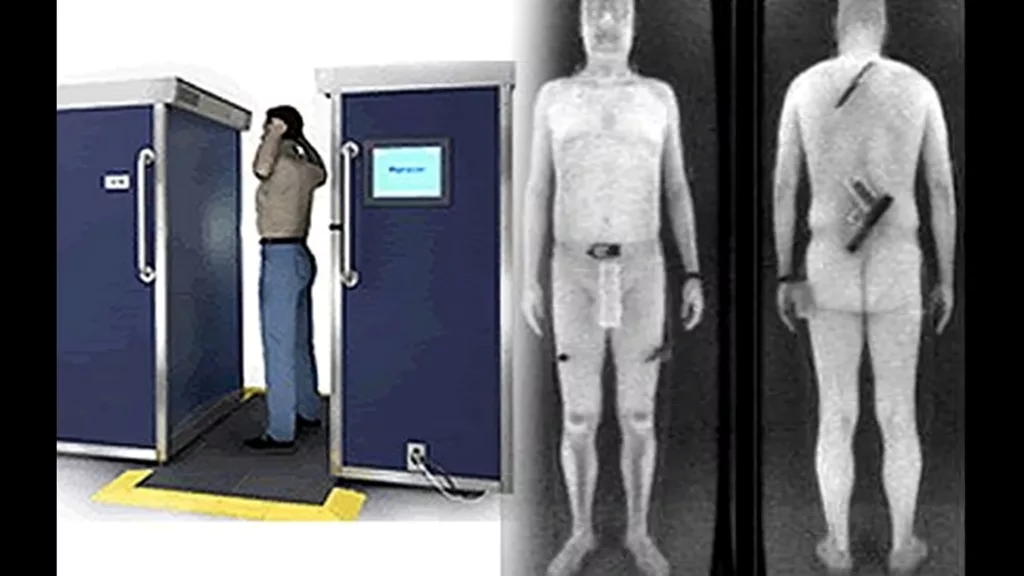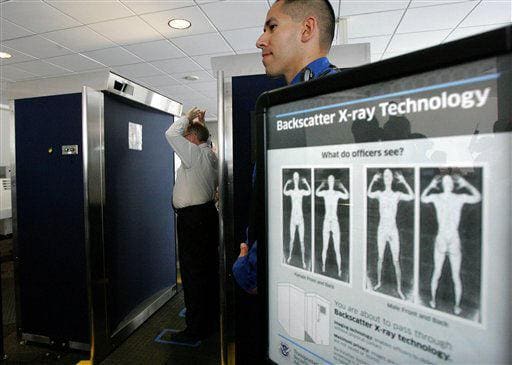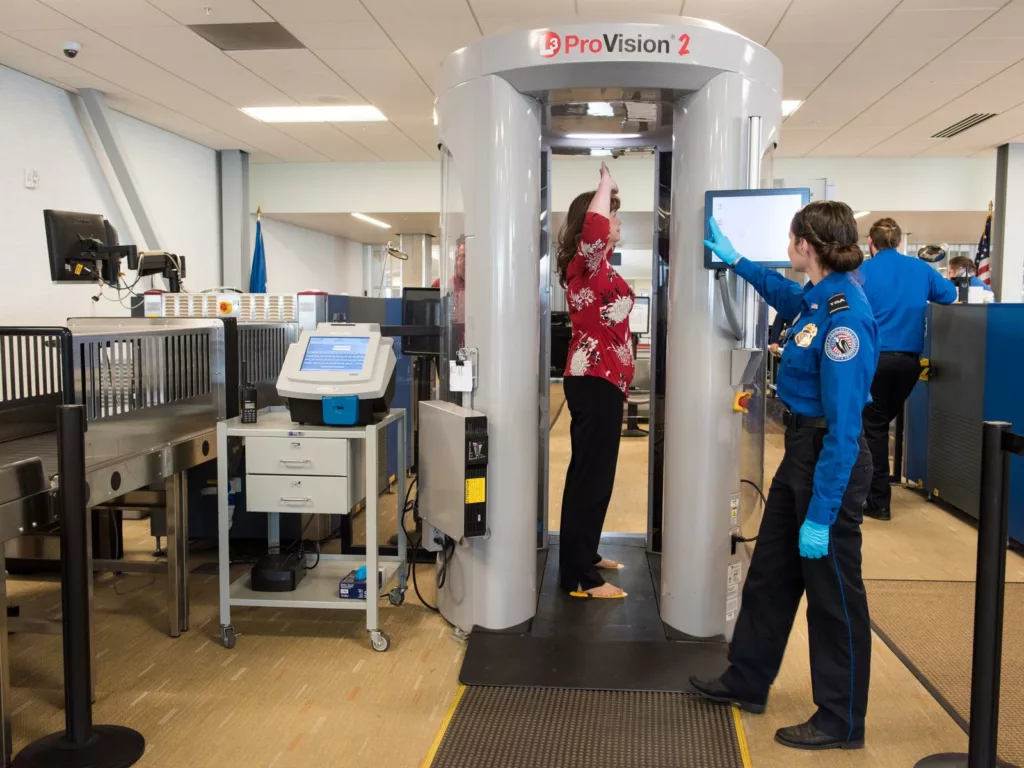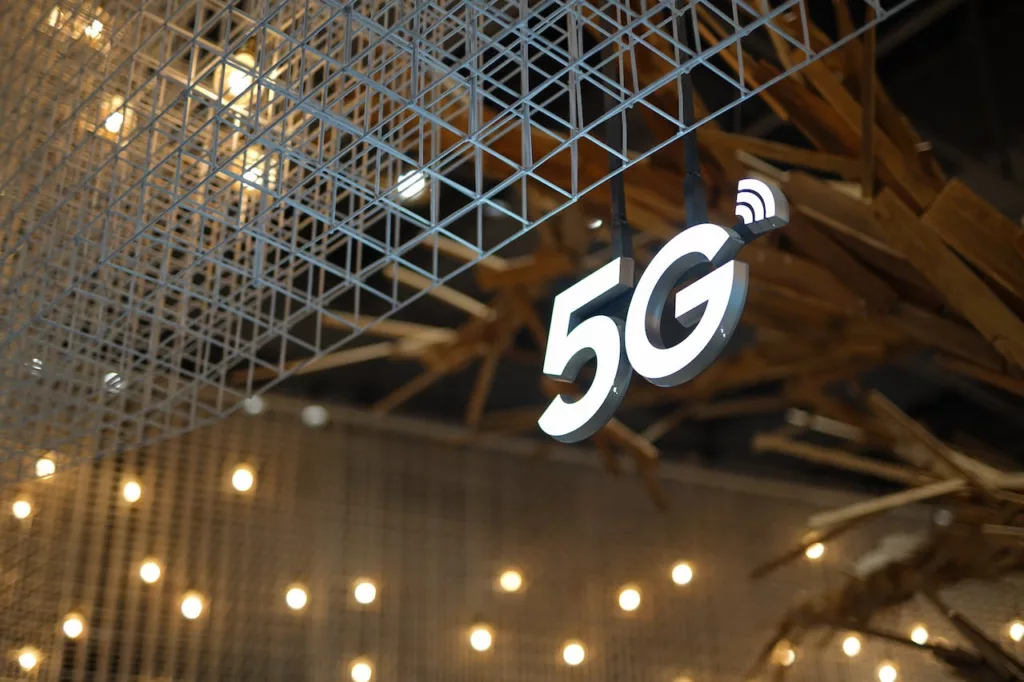Although airport security is a crucial part of air travel, one aspect of it has lately been receiving major attention: radiation"Radiation" in the context of Electromagnetic Fields (EMF) refers to the process by which energy is emitted and transmitted through space or a material medium in the form of electromagnetic... from airport security scanners.
Airport security scanners play a vital role in ensuring passenger safety. But in doing so, they also expose you to huge amounts of radiation, which, as we already know, is not good at all.
In this post, we’ll explain how airport security scanners work, explore what the deal is with radiation from airport security scanners, and look at an alternative to going through the body scan.
What Do Airport Body Scanners See?
While old metal detectors could only detect metal, the upgraded airport body scanners are also extremely good at finding non-metal objects.
This includes plastics, ceramics, rubber, liquids, gels, and powders. And, many incidents have shown us that such materials, although not very harmful on their own, could be used to create harmful objects.
These scanners are also designed with your privacy in mind. After scanning you, the machine only generates an image that looks like a mannequin.

Want to Slash Your EMF Health Risks?
Want to Slash Your EMF Health Risks?
Good! Learn the one small change you should make right now.
The software then simply highlights the parts that it wants the security agent to check before allowing you to pass through.
But how does it scan your body?
How Do Airport Scanners Scan Your Body?
Airport body scanners use radiation in the form of millimeter waves or X-rays, depending on the type of body scanner being used.
Different types of airport security scanners emit different types of radiation.
The ones that airports use commonly are backscatter X-ray scanners and millimeter waveThe term "wave" in the context of Electromagnetic Fields (EMF), frequency, and energy is a fundamental concept in physics and essential in understanding various natural phenomena and technological applications. A... scanners.
Let’s have a look.
Backscatter X-Ray
Backscatter X-ray scanners use a low-intensity X-ray beam to create an image of your body.
X-ray is a form of ionizing radiation"Ionizing radiation" refers to a type of electromagnetic radiation that carries enough energy to liberate electrons from atoms or molecules, thereby ionizing them. This form of radiation is part of..., which means that these rays have enough energy"Energy" is a fundamental concept in physics, often described as the ability to do work or cause change. In everyday terms, it's what is needed to move things, heat them... to remove electrons from atoms.
However, data shows that backscatter X-ray scanners typically emit 0.1 microsieverts (μSv) of radiation per scan.
That’s similar to the amount of radiation you receive from cosmic rays during two minutes of a flight.
Backscatter X-ray scanners are now old, and most airports around the world have changed to millimeter wave scanners.
And there begins the problem, which we’ll talk about in-depth later in this post.
Millimeter Waves Scanners
Millimeter wave (mmWave) airport scanners, also known as Advanced Imaging Technology (AIT) scanners, use active imaging technology to create detailed, three-dimensional images of passengers without using ionizing radiation like X-rays.
It does that in three steps.
Step 1: Transmission and Reflection
The scanner has many antennas that emit millimeter waves, similar to Wi-Fi signals but at a higher frequency"Frequency" in the context of electricity, Electromagnetic Fields (EMF), and wireless communication, can be thought of as the number of times something happens in a second. Specifically, it refers to.... These waves penetrate your clothing but reflect off your body to reveal any concealed objects.
The typical frequency range used by millimeter wave (mmWave) airport scanners falls between 30 GHz and 300 GHz.
Did you notice something? Yes, it’s the same frequency as advanced levels of 5G that haven’t yet been released to the public.
Step 2: Millimeter Wave Scanner Antennas
Another set of antennas receives the reflected waves and analyzes their strength and direction.
Step 3: Image Formation
The software then uses this information to reconstruct your 3D image. This image displays different materials based on how they reflect the waves, allowing identification of objects like weapons, explosives, and narcotics hidden under clothes.
If you have something suspicious on your body, the security agent may pull you aside for additional screening.
Is Airport Scanner Radiation Harmful?
The only problem with mmWaves scanners is that the data on how much radiation they expose you to isn’t publicly available. And it seems like no authorities are super keen on revealing this data.
Research papers like this from the Medical College of Wisconsin just say that we don’t have the numbers, but don’t worry, it’s non-ionizing radiation, so we’re fine.
But we already know that even non-ionizing radiation isn’t completely safe. In fact, we have thousands of peer-reviewed research studies demonstrating this.
And since we already know that these scanners operate on mmWaves, which fall between 30 GHz and 300 GHz, we just have to look at research on 5G"5G" refers to the fifth generation of wireless communication technology, a step up from the previous 4G, 3G, and 2G networks. It's designed to provide faster internet speeds, more reliable... and similar tech, and we have our answer.
5G Health Risks
In recent years, concerns regarding the health risks associated with 5G technology and electromagnetic fieldIn the context of electromagnetic fields (EMF), the term "field" refers to a region in space where electric and magnetic forces are exerted. An electromagnetic field is generated by electrically... (EMF) exposure have garnered significant attention.
Experts like Dr. Cindy Russell, Dr. Martin PallDr. Martin Pall, born on July 22, 1943, is a distinguished scientist renowned for his pioneering research in the field of electromagnetic fields (EMF) and their impact on health, particularly..., Dr. Zalyubovskaya, and Dr. David O Carpenter have voiced apprehensions based on a range of scientific studies.
Dr. Russell’s work has highlighted potential links between 5G millimeter wavelengths and health issues such as heart problems, birth defects, decreased antibiotic sensitivity, cataracts, and immune system suppression.
Furthermore, Dr. Martin Pall has outlined eight pathophysiological effects, including neurological impacts, endocrine disruption, oxidative stress, DNA damage, and fertility concerns, all of which may be exacerbated by the rollout of 5G.
Dr. David O Carpenter’s research suggests that radiofrequency radiation from 5G technology could potentially lead to cancer in animals, as evidenced by studies involving rats and mice.
You can learn more about the health risks of millimeter waves like the ones that 5G uses in my post, “What are the Health Risks of 5G? Your Questions Answered.”
Opt for A Pat-Down
If there were no other way, you’d have to endure going through the scanner for the sake of national security.
But you have another option, a safer one. And that’s to simply ask for a pat-down instead.
The country of the United States gives passengers the option to opt out of going through full-body scanners (such as millimeter wave scanners) at TSA checkpoints at airports.
Instead, passengers can request an alternative screening method, typically a manual pat-down conducted by a TSA officer.
This option is available for various reasons, including personal preference, privacy concerns, or medical conditions.
Key Points to Note
- You can refuse to go through a body scanner and do not have to provide a specific reason. According to several laws, the TSA is obligated to accommodate your request and provide an alternative screening method.
- The alternative screening method is generally a manual pat-down conducted by a TSA officer. And the pat-down needs to be performed with utmost professionalism and respect for privacy.
- You don’t have to have the pat-down right there in the scanner area. You can request that it be done in a private area.
Know Your Rights
If you’re being refused the option of a pat-down without any specific reason, here are some of the laws that protect you.
Fourth Amendment Rights
The Fourth Amendment of the US Constitution says that “the right of the people to be secure in their persons, houses, papers, and effects, against unreasonable searches and seizures, shall not be violated, and no Warrants shall issue, but upon probable cause, supported by Oath or affirmation, and particularly describing the place to be searched and the persons or things to be seized.”
In simple words, the Fourth Amendment protects you from being searched without a good reason. This is especially relevant at airports, where security checks are really thorough.
But since it’s also extremely crucial to maintain airport security, the Transportation Security Administration (TSA), which handles security, gives you a choice when you’re at the airport.
If you aren’t comfortable going through the full-body scanners for any reason, you can choose to have a pat-down instead.
TSA Policies and Regulations
The TSA, under the Department of Homeland Security, operates according to federal regulations and policies that dictate security screening procedures.
These policies are designed to comply with legal standards, including respecting individual privacy to the extent possible while ensuring security.
With Our Nation’s Security at Heart
You might be wondering if it’s really worth it to refuse to go inside the full body scanner and opt for a pat-down. After all, it’s a matter of national security.
If you are, let me also point out that you’re simply choosing one of the options that TSA provides. You are not at all compromising national security by asking for a pat-down.
It just so happens that one of the options that TSA provides aligns with the principle of minimizing your EMF exposure when possible.
You’re still acting in the nation’s interest. And there’s no need for guilt in making a choice that considers your health.
Final Thoughts
As we reflect on the balance between personal health and national security at airports, it’s clear that being proactive about our choices is key.
While opting for a pat-down is one step, there are further actions we can take to minimize EMF exposure during air travel. This is where Cathy Cooke’s expertise comes in.
Her course, Fly Healthier & Feel Better, offers a wealth of practical advice and deep knowledge in EMF and Building Biology. Designed for all travelers, her course provides accessible, engaging modules and valuable resources to enhance your journey.
Whether you’re a frequent flyer or planning a long trip, this course offers valuable insights to enhance your travel well-being.
Join now for a deep dive into healthier flying.














